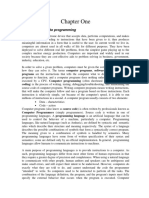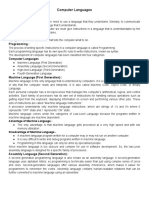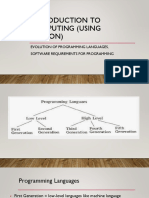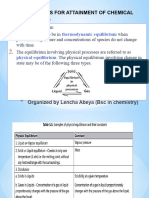0% found this document useful (0 votes)
11 views3 pagesUNIT 5. Programming Languages
This document provides an overview of programming languages, emphasizing the distinction between high-level and low-level languages, and the role of assembly language. It explains the process of programming, the necessity of translating code into machine language, and the classification of programming languages based on syntax and semantics. Additionally, it highlights the importance of programming language theory within computer science.
Uploaded by
danielamouandaCopyright
© © All Rights Reserved
We take content rights seriously. If you suspect this is your content, claim it here.
Available Formats
Download as DOCX, PDF, TXT or read online on Scribd
0% found this document useful (0 votes)
11 views3 pagesUNIT 5. Programming Languages
This document provides an overview of programming languages, emphasizing the distinction between high-level and low-level languages, and the role of assembly language. It explains the process of programming, the necessity of translating code into machine language, and the classification of programming languages based on syntax and semantics. Additionally, it highlights the importance of programming language theory within computer science.
Uploaded by
danielamouandaCopyright
© © All Rights Reserved
We take content rights seriously. If you suspect this is your content, claim it here.
Available Formats
Download as DOCX, PDF, TXT or read online on Scribd
/ 3
























































































